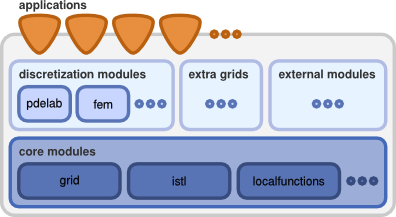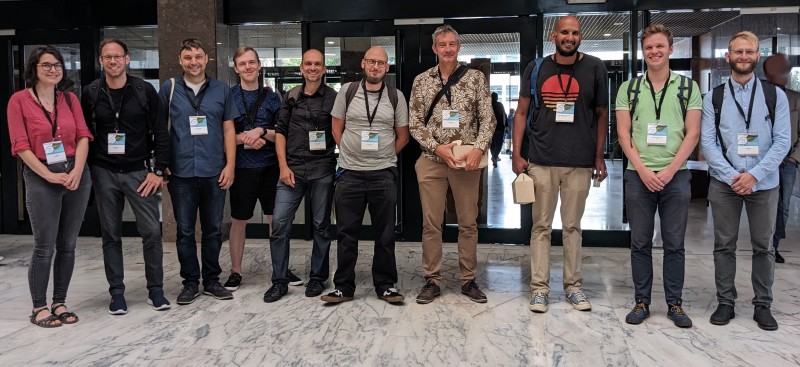DUNE Numerics
DUNE
DUNE, the Distributed and Unified Numerics Environment is a modular toolbox for solving partial differential equations (PDEs) with grid-based methods. It supports the easy, flexible, and efficient implementation of finite element and finite volume methods. DUNE is written in C++, but has interfaces to Python as well.

The underlying idea of DUNE is to create slim interfaces allowing an efficient use of legacy and/or new libraries. Modern C++ programming techniques enable very different implementations of the same concept using a common interface at a very low overhead. Thus DUNE ensures efficiency in scientific computations and supports high-performance computing applications.
Particular highlights are:
- A generic interface for finite element grids. This interface allows to use a wide range of very different grid data structures from the same code
- An interface for finite element bases, together with a generic mechanism to construct complicated bases from simpler ones
- The Iterative Solver Template Library, featuring vector and matrix data structures that allow for many general nesting patterns
DUNE is free software licensed under the GPL (version 2) with a so called “runtime exception” (see license). This licence is similar to the one under which the libstdc++ libraries are distributed. Thus it is possible to use DUNE even in proprietary software.
Latest News 
A Matrix room for DUNE
We have a new communication channel. There is now a dedicated chat room on matrix.org for all topics related to DUNE. You can join the room via this link, or get somebody to invite you.
Matrix is an open federated protocol for real-time communication. Many institutions provide their staff with a matrix identity nowadays. If your institution is not on the list, ask them for a matrix homeserver. While you wait, you can get free accounts from (e.g.) matrix.org.
DUNE 2.9.1 released
The 2.9.1 release is now available.
You can download the tarballs (
dune-common,
dune-geometry,
dune-grid,
dune-localfunctions,
dune-istl
) or checkout the v2.9.1 tag via Git.
DUNE@Enumath
FILE EXISTS
 DUNE@Enumath
DUNE@Enumath
This years Enumath conference (European Conference on Numerical Mathematics and Advanced Applications) took place in Lison, Portugal.
Many interesting presentations involved simulations performed with DUNE. Furthermore we took the chance to meet and discuss in person with several DUNE developers and users from all over Europe.
Dune User Meeting Sept. 18-19, 2023
We are organizing the 7th DUNE user meeting at the Technical University Dresden September 18-19, 2023. Directly afterwards the developer meeting will take place September 19-20, 2023.
This meeting offers a chance to showcase how you are using Dune, foster collaborations between the users and provide input to the future development of Dune. The meeting also welcomes contributions from other frameworks such as DuMuX, AMDiS and OPM that are using Dune.
To help the organizers please choose to register soon on the user meeting page and the developer meeting page. You will also find more information about the meetings there.
Please note that the official registration deadline is August 19, 2023.
DUNE 2.9.0 released
The 2.9.0 release is now available.
You can download the tarballs (
dune-common,
dune-geometry,
dune-grid,
dune-localfunctions,
dune-istl
) or checkout the v2.9.0 tag via Git.
Pip packages are also available which can be installed using pip.
Please go and test, and report any problems that you encounter.
 |
Legal Statements / Impressum |
Hosted by TU Dresden |
generated with Hugo v0.111.3
(Oct 13, 22:25, 2024)
|
Legal Statements / Impressum |
Hosted by TU Dresden |
generated with Hugo v0.111.3
(Oct 13, 22:25, 2024)